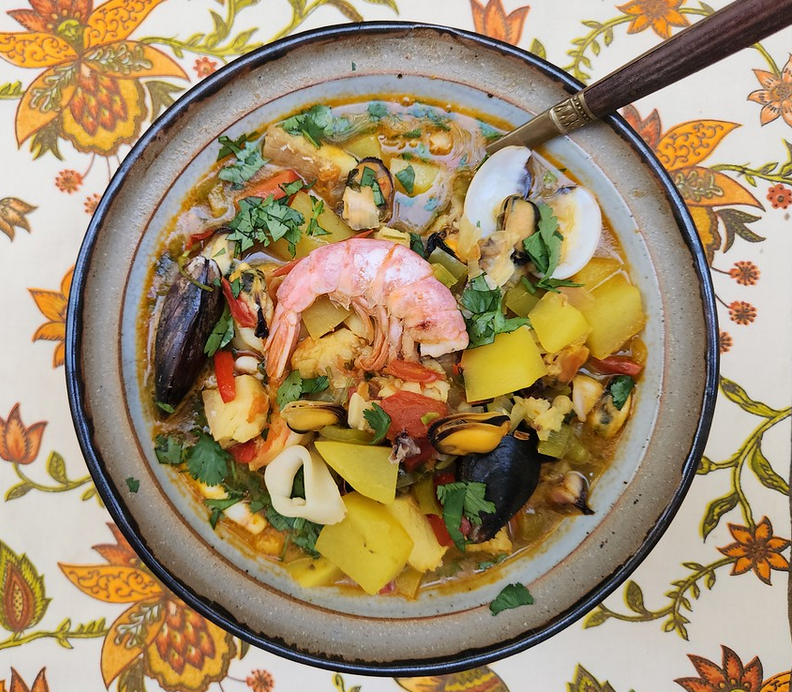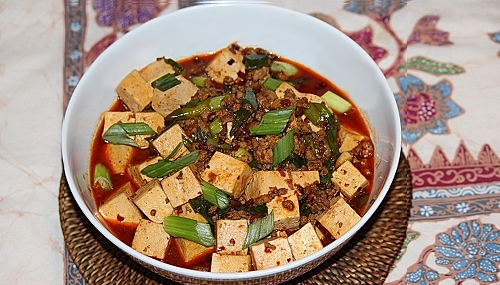
Mapo Dofu (麻婆) is a highly popular tofu dish that can be found in Chinese restaurants all over the world. It is so popular in Japan than many people think it is a Japanese dish, but it hails from Sichuan (Szechuan) province in China. There are many variations, but what is essential to nearly all Mapo Dofu recipes is tofu, scallions (green onions), Sichuan peppercorns, fermented chili sauce and fermented fava beans or bean sauce. Either ground pork or beef is often added and sometimes water chestnuts, wood-ear mushrooms. It is most typically prepared using only the base ingredients.
The term "Mapo" is contraction of the Chinese ideograph "mazi" (麻子) meaning "pockmarked" and "po" (from "po po" (婆婆)) meaning "old woman". The story has it that the dish was created by a woman named Chen who lived outside of Chengdu in the late 19th century (during the Qing Dynasty). Chen had been stricken by smallpox which disfigured her which made her a social outcast. Because of this she lived on the outside of town, but her fortunes changed when she invented Mapo Dofu which she sold from her from her restaurant known as Wanfu Qiao (Wanfu Bridge). Chen's place was mentioned in the 1909 book "Chengdu Tonglan: A General View of Chengdu" a guide to the best restaurants and street food in the city. Today in Chengdu a chain of restaurants bear the name Chen Mapo Dofu whose owners claim direct descendance from the original Chen.
One of the essential ingredients in Mapo Dofu is Sichuan peppercorns (from the prickly ash tree). It tastes different than most pepper, has an anaesthetic effect in your mouth. It is often called prickly ash on the package. It is claimed that Mapo Dofu made in Chengdu uses very generous amounts of the pepper making the dish there hotter than typical versions prepared and sold in restaurants outside of China where some versions are decidedly mild in spiciness. The pepper we used was not particularly hot, but it did have a numbing effect. Mapo Dofu also uses a generous amount of oil, Chengdu is well known for the production of rapeseed oil, more commonly known as Canola oil in the United States. Although native to more southern and equatorial climes, the broad beans (fava) which are used in the form of a fermented paste are so popular in Sichuan they are sometimes referred as "Sichuan beans" outside of China. Note that many preparations of hot bean paste are made with soybeans not fava or broad beans.
Ingredients:
- 1/2 pound ground pork
- 1 package of medium to firm tofu cut into 3/4 inch cubes
- 4 scallions (green onion)
- 1/2 cup chicken stock
- 2 teaspoons Chinese fermented chili sauce
- 2 Tablespoons fermented black bean paste
- 1 - 2 teaspoons toasted Sichuan peppercorns
- 1 tablespoon minced or grated ginger
- 1 tablespoon minced or crushed garlic
- 1 heaping teaspoon cornstarch
- 2 tablespoons rice wine or sherry
- cooking oil (canola, peanut or sesame)
- Rice
Preparation:
- Start cooking the rice. Mapo Dofu does not take long to prepare so begin by cooking the rice.
- Cut tofu into 1/2 to 3/4 inch cubes.
- Heat a pot of water to boiling and then simmer the tofu for about 5 minutes and then drain.
- Grate the ginger, crush the garlic,
- Slice the scallions into diagonal strips about 1/2 inch wide. Although most recipes call for just the green part, using the white part is fine.
- In a wok with a tiny bit of oil, toast the Sichuan pepper for about a minute. Stir constantly and don't burn them.
- Remove and set aside the peppercorns.
- Brown the pork in the wok breaking it into small bits with your spatula.
- Remove the cooked pork and set aside.
- Mix the cornstarch into the chicken stock and set it near your stove for quick access.
- In a small amount of oil fry the garlic, ginger, chili sauce and bean paste for about a minute.
- Mix in the sliced scallions and cook for another 30 seconds.
- Add the tofu, pork and rice wine to the wok.
- Quickly give the chicken stock a vigorous stir to re-mix the corn starch and then pour the liquid over the contents of the wok.
- Gently mix (fold) the ingredients being careful to not break up the tofu.
- Cook for another minute until heated through. Sprinkle the top with the Sichuan peppercorns.
- Remove from heat and serve with rice.
Enjoy!
Recipe by T. Johnston-O'Neill
Photo by Emily Johnston-O'Neill
Recipe suggested by Zhongchao Liao
- Details
- Hits: 4253
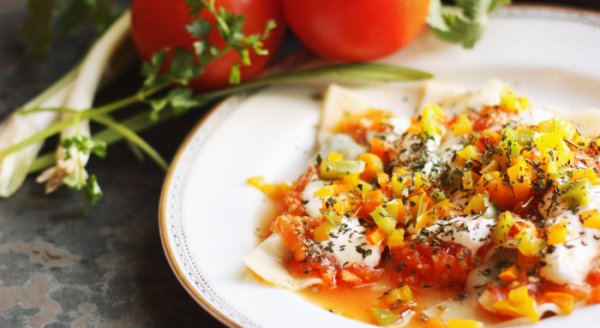
The Participant Observer Recipe of the Month is: Afghan Ravioli known as Aushak. A delicious pasta dish that eaten for special occasions. It can be made entirely vegetarian or prepared with a beef or lamb sauce. Tangy yogurt sauce give this dish an unique taste.
Aushak (also spelled Ashak), is a traditional Afghan dish made of savory dumplings that are covered with a tomato sauce, yogurt and dried mint. This dish is often referred to as 'Afghan Ravioli.' It can be made vegetarian or with beef or lamb. The combination of the tangy yogurt sauce with the savory ravioli and tomato sauce is what makes this dish so unique and delicious. Aushak hails from the city and region surrounding Kabul. The raviolis are filled with gandana greens, also called tareh in Persian. They are part of the Elephant Garlic family and are similar to common chives, although larger and flatter. They are sometimes known as Persian or Chinese chives.
The yogurt sauce consists of kashk (which is made from drained sour milk or yogurt and then dried) and labneh (thick yogurt that has been strained to remove its whey) to create a very tangy topping. Labneh is a common ingredient in Middle Eastern cuisine. It can often substitute for cream cheese, such as on bagels. If you're feeling ambitious, you can find a recipe online and make your own labneh. Pasta is called khameerbob in Afghanistan. A reasonable substitute is East Asian gyoza wrappers, which are used for this recipe. Khameerbob is rather labor intensive, which is why in Afghanistan aushak is reserved for special occasions. The raviolis can also be assembled and cooked ahead of time and stored in your refrigerator or freezer. How the ravioli is folded and the range of ingredients used varies from cook to cook—feel free to experiment. Alternative ingredients are suggested for the most authentic taste. Purchase the original ingredients from an international market.
Ingredients:
Note: Gandana chives, kashk and labneh can all be purchased at the Balboa International Market, Sahel Bazaar or North Park Produce.Ravioli
- 1 packet round gyoza wrappers (we like Hong Kong brand best—available at 99 Ranch Market). Square wonton wrappers may also be used.
- 1/2 bunch cilantro leaves
- 2 to 3 bunches chopped gandana(or leeks, chives or scallions), Gandana/tareh is available at
- 1 teaspoon salt
- 4 to 6 cloves crushed garlic
- 1 tablespoon freshly ground coriander
- 1 teaspoon black pepper
- 1 teaspoon cayenne pepper (or to taste)
- 1/4 cup corn oil or vegetable oil
- 1/2 lb ground beef or lamb
- 1/2 red bell pepper
- 1/2 yellow bell pepper
- 1/2 orange bell pepper
- 1/2 teaspoon salt
- 1/2 teaspoon cayenne
- 1/2 teaspoon ground coriander
- 6 large tomatoes, or one 14.5-ounce can of crushed tomatoes or tomato sauce
- 2 tablespoons olive oil
- 1 teaspoon cayenne, or to taste
- 1 teaspoon ground coriander
- 1 teaspoon crushed garlic
- 3 tablespoons kashk
- 1/3 small container of labneh (if kashk isn't available, mix equal parts labneh and yogurt)
- 1 teaspoon water
- 2 tablespoons dried mint (or more to taste) to sprinkle on top. (Note: some recipes call for fresh mint)
Preparation:
Based on recipe submitted by Farida and Leslie Dufour Check out their international cuisine site at: Culture and Cuisine. Photos by Hilary Dufour.
|
- Details
- Hits: 4172
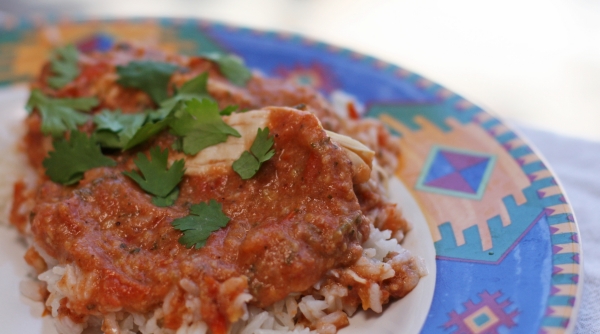
Oaxacan Stew (Estofado de Oaxaca) originated in the predominantly indigenous state of Oaxaca, Mexico, the stew belongs to a unique cuisine that has received world-wide culinary appreciation. This spiced stew contains many ingredients typically found in this region of southern Mexico.
Oaxaca is a southern state in Mexico. The majority of the population in Oaxaca is indigenous with Mixtecs and Zapotecs (58% of the population) people being the most numerous. It is estimated that over half of all people who speak indigenous languages in Mexico live in the state of Oaxaca with nearly half the population not speaking Spanish fluently or at all. Because of this cultural heritage, while Oaxacan food does share ingredients with other parts of Mexico, some of their foods are quite unique. Oaxaca is famous for its huge variety of sauces known as mole prepared from a diverse number of ingredients but typically containing one or more types of hot peppers. The state is sometimes referred to as the "Land of Seven Moles" reflecting the seven basic types of sauces found there: negro (black), amarillo (yellow), coloradito (colored), mancha manteles (tablecloth stainer), chichilo (named after the main pepper), rojo (red) and verde (green). Often the mole is considered more important to a dish than the meat, pulses or vegetables that are smothered in the mole. One delicacy found in Oaxaca are chapulines or grasshoppers that are semi-domesticated and raised specifically for human consumption. Many different spices are used in Oaxacan cuisine besides numerous kinds of peppers, including cinnamon, oregano, anise, cloves, cumin, thyme, sesame seeds, marjoram and allspice. Favored ingredients also include plantains, tomatoes, onion, tomatillos, garlic, nuts (particularly almonds), limes and chocolate. The recipe below contains many of these ingredients.
This stew is a family recipe and is a reflection of the flavors and aromas developed by the great cooks from the state of Oaxaca. Estafado means stew; this particular estafado (stew) from Oaxaca blends nuts, spices, bananas and capers to create an intriguing aromatic dish perfect for a family or festive dinner.
To prepare this dish you will need a spice grinder (or mortar and pestle), a blender or food processor and a large skillet.
Ingredients:
- 6 large unripe tomatoes chopped into quarters (red, but with green color
remaining,if possible) - Green olives stuffed with pimentos (optional)
- 1 teaspoon capers
- ½ bunch Italian parsley
- 1 white onion
- 1 plantain (cooking banana)
- 2 ounces natural style sesame seeds style (Guapo brand are a good choice,
they are darker in color than regular sesame seeds. - 1 pound of chicken breasts, chicken tenders or dark meat chicken cut
into large pieces - 1 corn tortilla
- ½ stick of Mexican cinnamon ("canela") Mexican cinnamon is a must, because
of its soft texture.) - 10 allspice seeds
- 15 whole cloves
- 1 teaspoon oregano
- 6 cloves garlic
- ¼ cup raisins
- ¼ cup peeled almonds
- 1 cup chicken broth (optional)
- Cilantro for garnish
Preparation:
- Boil quartered tomatoes, three cloves of garlic and ½ chopped onion until soft. Use just enough water to cover the vegetables.
- After ingredients are soft, let everything cool for 10 minutes.
- In a blender or food processor, puree the cooled ingredients.
- Bring water to boil in a pot and add the chicken, 3 garlic cloves, ½ white
onion and 1 teaspoon salt. - Boil gently until the chicken is cooked through.
- In a large frying pan fry quartered plantains in vegetable oil until
slightly browned. Remove from pan and set aside. - Gently heat corn tortilla in same pan and set aside.
- In same pan, brown the sesame seeds for a few minutes, turning them
continuously to ensure they don't burn. Set aside to cool. - Grind in a spice grinder or a mortar and pestle all the spices (cooled
sesame seeds, cinnamon, cloves, allspice and oregano into a smooth powder. You
may have to do this in batches. - In blender or food processor blend the spice mixture, parsley, cooked banana, almonds, oregano, raisins and tortilla into a thick paste.
- Mix in ½ -1 cup liquid-either water or the remaining water from cooking the tomatoes, or chicken broth.
- In large frying pan gently sauté this mixture with 1-2 tablespoons
vegetable oil, finally letting it simmer gently for ten minutes. Add
additional liquid if necessary to prevent sticking. - Carefully add the blended tomato mixture to the liquid spice mixture in
frying pan. - Simmer for an additional 10-15 minutes
- Add to the simmering pan the cooked chicken, capers, olives salt to taste,
and a pinch of sugar if desired. - Simmer for a few more minutes.
Serve over rice, garnish with cilantro and eat with warm corn tortillas.
Recipe submitted by Hilary Dufour from Veronica and Culture and Cusine.
Photo by Hilary Dufour
- Details
- Hits: 5392
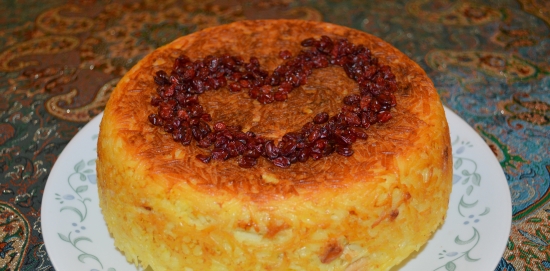
Iranian Tah-Chin Morgh is from relatively simple ingredients, this rice and chicken timbale has a golden crispy crust and a great blend of ingredients that will delight your dinner guests.
Tah-Chin (Also: Tah chin, Tahchin, Persian: ته چین) is an Iranian rice cake (or timbale) made out of rice, meat (chicken is common), yogurt, eggs and plenty of saffron. The yogurt and egg yolks make a custard that makes the dish firm. Due it is deliciousness and beautiful shape, Tah-Chin is one of the best Iranian dishes for formal feast. Iranians love rice and love to layer it with different types of vegetables and meat. "Tah" is a Farsi word for bottom and "chin" is the root word for "chidan", which means putting things in order, arranging, and in this case, layering. I think that the tastiest part of this dish is the crispy bottom layer, which is called Tah Dig. In fact, it is typical in restaurants to be served just the Tah Dig, not the rice on top of it. There are different types of Tah-Chin including spinach, fish, and lamb, although chicken is the most popular. Either white meat or dark meat can be used. Tah-chin is often served with plain yogurt, salad Shirazi, or torshi. This dish uses long-grain basmati rice, which is now widely available. Tah-Chin is built in layers. It has relatively simple ingredients but requires a bit of time (well over an hour) for all the cooking stages. The final stages are cooked in a slope-sided round saucepan of approximately three quarts. After the Tah-Chin is cooked, it is inverted onto a serving plate revealing a crunchy golden top. To save some money, purchase the saffron at Trader Joe's, a Middle-eastern or Indian grocery.
Ingredients:
- 2 chicken breasts or 1 pound of boneless chicken (dark meat).
- 1 large onion, thinly sliced
- 2 cups thick full-fat yogurt
- 2 egg yolks
- 1/2 teaspoon saffron threads
- 3 cups basmati rice
- 1/2 cup Zereshk (Dried Barberries)
- 1/2 cup shelled unsalted pistacios (optional)
- Cooking oil
- 1 teaspoon of sugar
- salt & pepper to taste
Preparation:
- Place chicken, chopped onion and a teaspoon of salt in a saucepan and fill with enough water to just cover the ingredients.
- Bring saucepan to a boil, then lower to a simmer for 30 minutes until chicken is fully cooked.
- Soak saffron threads in a half cup of very hot water.
- In a large mixing bowl, beat the yogurt until it is smooth.
- Add the egg yolks, cooked onion, saffron, salt, pepper to the yogurt and mix well.
- After the chicken is cooked, remove it from the pot and set it aside to cool.
- In a large pot, cook 3 cups of Basmati rice in 6 cups of water for about 10 minutes. The rice should not be fully cooked at this point. Many people soak Basmati for a half hour or longer before cooking. This makes the rice fluffier.
- Add 2 cups of the partially cooked rice (you will use the remainder of the rice later) to the yogurt mixture and blend well.
- When the chicken is cool enough, shred it, but not too finely.
- Ladle 2/3 of the rice and yogurt mix into the sauce pan, flatten with a wooden spoon.
- Layer chicken pieces evenly on top of the rice.
- Cover this layer with a layer of rice. Smooth and flatten with a spoon.
- Cover the rice with another layer of the yoghurt/rice mixture. Smooth and flatten with a spoon.
- Repeat steps 11 through 13 until all the ingredients have been used.
- Place the pot on medium-high heat.
- When steam starts to emerge, set the heat to low, cover and cook for one hour. The goal is to get the lower part of the dish to a nice brown color and form a crust without burning it.
- When fully cooked, let the Tar-chin cool for a few minutes so that it it easier to remove from the pan.
- Place a large round serving platter on the top of the pan. Gently flip the pot over the plate to separate the Tah-chin from the pan.
- Finally, decorate your Tah-chin with Zereshk (dried Barberries). Gently fry the Zereshk in a little oil with a teaspoon of sugar and pinch of saffron. Fry for about 1 minute but Zereshk burns very easily so be careful! Cooks also frequently decorate Tah-chin with shelled pistachios, which look nice and taste great with the barberries. You can purchase both Zereshk and pistachios at the Balboa International Market.
Befarma'id! بفرماييد (Bon Appetit in Farsi)
Recipe and photo by Tayebe Aghaei
- Details
- Hits: 3910
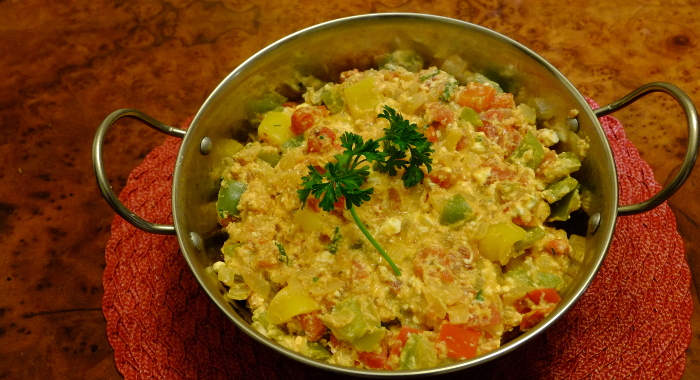
The Participant Observer Recipe of the Month is Turkish Menemen (accent on the 2nd syllable). If you have been reading Participant Observer for a while, you probably know we have a certain affection for street food. This dish has few ingredients, couldn't be easier to prepare, and tastes delightful!
Menemen is traditionally cooked and served in a tin-clad copper pan called a sahan. A large deep frying pan is an adequate substitute. With simple ingredients and the fact that everything is cooked in one pan, it is the epitome of high taste but low effort cooking! When served in restaurants, the edges of menemen are sizzling hot. When served in homes, it is served in a large pan set in the middle of the table from which all share. Menemen can be eaten as a snack, for breakfast, lunch or dinner. When eaten as a breakfast it can become an elaborate affair and can include cheese (beyaz peynir, similar to feta), cured olives, sweeten cucumber quarters, a variety of breads along with Turkish spreads and jams, walnuts, raisins, dried apricots, spicy sausage (sucuk) or cured beef (pastirma). Breakfast is washed down with fresh orange juice and Turkish tea brewed in a "double teapot" (similar to a percolator) know as a Çaydanlik. The basic recipe has few ingredients, but many cooks add whatever pleases them at the moment. Every version uses sweet green peppers but many cooks also add either hotter peppers or crushed pepper flakes (Allepo or Urfa dried chilies are two very popular varieties). Menemen is typically eaten with good crusty bread (that can be dipped into the delicious gravy). When fully cooked, the Menemen should still be on the wet or runny side. Some cooks like to blend the eggs into the dish, others prefer to cook the eggs on the top of the simmering tomatoes and peppers. The dish gets its name from Menemen in the North of Izmir.
Ingredients:
- 4 Tablespoons of extra-virgin olive oil
- 3 Large peeled and diced red tomatoes (or a 14.5 oz can of diced tomatoes)
- 3 Bell Peppers, seeded and diced (note: green, red and yellow peppers can be used)
- 3 Medium onions, diced
- 3-4 Eggs
- 1/4 Cup of crumbled feta cheese (or beyaz peynir if you can find it!)
- 1 Tablespoon of chopped parsley
- 1 Teaspoon of dried oregano
- Dried chili flakes to taste (optional)
- Salt and pepper to taste
Preparation:
- In a large straight-sided skillet (or sahan), saute, on medium-low flame, the onions and peppers in olive oil until the onions are translucent.
- Add the diced tomatoes and peppers, and simmer until the peppers are soft (but not mushy).
- .Blend in the oregano.
Version 1:
- Lightly whisk the eggs in a mixing bowl.
- Stir the eggs and parsley into the tomato/pepper mixture.
- Continue cooking for another 1/2 minute at the most. Again, this dish should be moist, not dry, and the eggs should be under rather than over-cooked.
Version 2:
- Crack open the eggs over the simmering dish.
- Continue cooking until the egg whites are soft-cooked and the yokes are still mostly liquid.
- Sprinkle chopped parsley over the dish.
Both Versions:
- Remove pan from heat.
- Sprinkle on top (or mix in) the crumbled feta cheese, chili flakes, salt and black pepper.
- Serve with a good crusty bread suitable for dipping in the Menemen and one or more of the side ingredients mentioned above.
Afiyet olsun!
Recipe by T. Johnston-O'Neill
Photo by Jiaoting (Tina) Yao.
- Details
- Hits: 3953
Joomla!
Extensions
The Joomla! content management system lets you create webpages of various types using extensions. There are 5 basic types of extensions: components, modules, templates, languages, and plugins. Your website includes the extensions you need to create a basic website in English, but thousands of additional extensions of all types are available. The Joomla! Extensions Directory is the largest directory of Joomla extensions.
Components
Components are larger extensions that produce the major content for your site. Each component has one or more "views" that control how content is displayed. In the Joomla administrator there are additional extensions such as Menus, Redirection, and the extension managers.
Modules
Modules are small blocks of content that can be displayed in positions on a web page. The menus on this site are displayed in modules. The core of Joomla! includes 24 separate modules ranging from login to search to random images. Each module has a name that starts mod_ but when it displays it has a title. In the descriptions in this section, the titles are the same as the names.
Content Modules
Content modules display article and other information from the content component.
User Modules
User modules interact with the user system, allowing users to login, show who is logged-in, and showing the most recently registered users.
Display Modules
These modules display information from components other than content and user. These include weblinks, news feeds and the media manager.
Utility Modules
Utility modules provide useful functionality such as search, syndication and statistics.
Navigation Modules
Navigation modules help your visitors move through your site and find what they need.
Menus provide your site with structure and help your visitors navigate your site. Although they are all based on the same menu module, the variety of ways menus are used in the sample data show how flexible this module is.
A menu can range from extremely simple (for example the top menu or the menu for the Australian Parks sample site) to extremely complex (for example the About Joomla! menu with its many levels). They can also be used for other types of presentation such as the site map linked from the "This Site" menu.
Breadcrumbs provide users with information about where they are in a site.
Page 23 of 28








